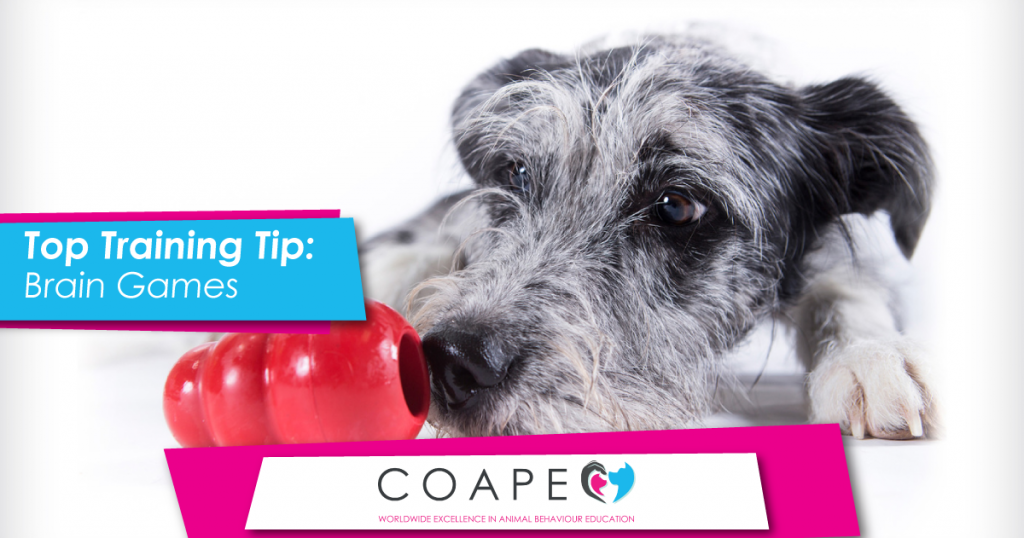Brain games are activities that enrich our dogs’ lives by giving them something to keep them mentally busy, without them having to exert a large amount of energy, as they would on a walk.
Now and then your dog might have problem that prevents you from walking him. This could include a physical injury, anxiety or even aggression towards people or other dogs, a rainy week could be keeping you indoors, or you spend long hours at work. When your dog is stuck indoors for whatever reason, you can use these brain games as a substitute for walking.
Because these activities focus on mental stimulation, they can help to combat behaviour problems stemming from boredom.
Disclaimer: any behavioural issues like aggression should always be assessed by a COAPE qualified animal behaviour practitioner as soon as possible.
Here are some great ideas to keep your dog mentally occupied on days when he needs a bit more than a cuddle and a snooze.
- Find a biscuit under the cup:
Put a particularly tasty treat under an upturned cup, and then place another empty cup next to it. Encourage your dog to “find it.” If he nudges the correct cup, give him an enthusiastic “YES!” (or you can click if he’s clicker trained). Immediately lift the cup and let him eat the treat. The better he gets at this game, the more challenging you can make the test: add more cups, move them further apart, put the treat under the cup when he can’t see what you’re doing, or shuffle the cups around while he watches.
- Treat in a muffin tin:
Using a normal muffin tin, put a treat in each hole and put a ball on top of the treat. Your dog will have to push the ball out of the hole to get at the treat! Start with a light, small ball like a Ping-Pong ball and increase the difficulty of the game by using heavier and bigger balls like tennis balls.
- Fetch:
Fetched should only be played if your pet has no physical injury or ongoing medical condition such as hip dysplasia.
Play fetch games with your dog and enthusiastically let him know what a clever dog he is for retrieving. Reward him with a treat in the beginning when he lets go of the ball to teach him that another part of “fetch” means “let go”. You can also ask him to sit or lie down and wait for a few seconds before throwing the ball. Vary the length of time that he has to wait for the fetch cue. This simple little exercise can help him to practice self-control and will teach him frustration tolerance.
- Hide and Seek:
For this fun game with your dog you will need more than one person. To play “hide and seek” with him, one person holds him while another goes to hide somewhere in the house or garden. When ready, just call him. The person who held him can help him initially by encouraging him in the right direction. When he succeeds in finding the hidden owner, make a big fuss and reward him with a tasty treat.
- Find the biscuit:
In this game, you would start off by putting your dog in a sit/stay, then placing a biscuit somewhere obvious in plain sight. Let him wait for a few seconds, and then encourage him to “find it!” When he does, he gets the biscuit, plus another treat and heaps of praise. Increase the difficulty of the games by hiding the treats in increasingly difficult to find places.
- Mock tracking games:
All dogs are able to track and this game gives them the opportunity to earn huge rewards. First, you need to prepare the environment without your dog around to see you. Place biscuits, Vienna sausage, kibble, etc. on a trail around the garden or home. Start with one clue every half meter), leading up to the jackpot find, which will be a handful of treats. When he finds these, praise him enthusiastically while he eats the yummies. Increase the difficulty of this game by making the distance between clues longer.
- Brain Toys:
Instead of putting your dog’s food in a food bowl, try to either give him a treat ball or a Kong, where he has to work to get his food out.
A treat ball can be used to give a dog all his daily meals. Instead of putting the kibble in a bowl, place it in the ball and let him work out how to roll the toy to get his food out.
Kongs are available from all good pet stores and are made of pure rubber, meaning they’re pretty much indestructible. These toys are also food dispensing toys. They work on the same principle of a marrow bone: something that your dog can chew, but mainly stuffed with something soft that he can lick out. For information about how to introduce your dog to a Kong, please visit https://www.youtube.com/watch?v=0EuY98sRPb8
- Flavoured ice blocks:
These can be made by taking a 2 litre ice cream container and filling it with either chicken or beef stock, or fruit juice if your dog has a sweet tooth. You can mix treats such as biscuits, bits of dried wors, or viennas into the liquid and then freeze it overnight. By giving him the block of ice to lick you can keep him busy for hours on end. This is especially great in summer when your dog will most enjoy the icy treat.
Whichever way you choose to keep your dog mentally stimulated always remember to start easy and slowly increase the difficulty of the game. Just like us, if it’s too hard for your dog and he keeps losing at the game, he’s not going to want to play anymore. Always set your dog up for success.
Also remember that not everything is going to come naturally to your dog and he may need some encouragement from you – especially if he’s never played a brain game before. Use the opportunity to make it a fun game for both of you to play together, and once he’s got the hang of it you can leave him to play on his own.





